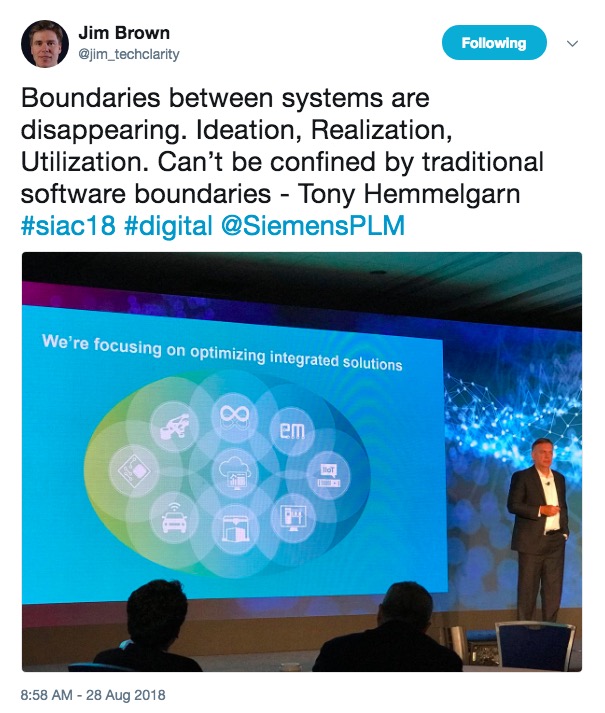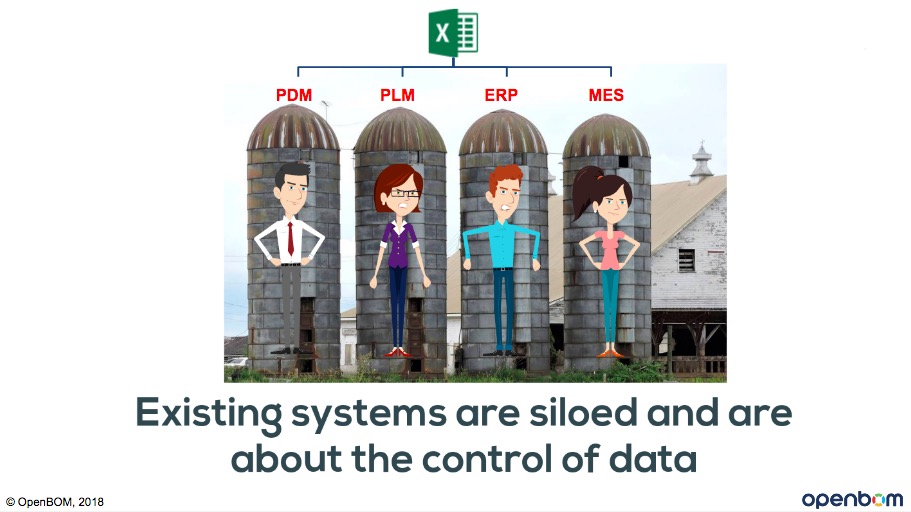
I’m following Siemens PLM Analyst Conference this time online via Twitter. Check the following Twitter hashtag – #SIAC18. There are lot of information and visuals coming from my tweeting friends in analyst community – Allan Behrens, Jim Brown, Chad Jackson, Monica Schnitger.
One slide that caught my special attention was related to rethinking of current software boundaries. Check this picture:

Boundaries between systems are disappearing. Ideation, Realization, Utilization. Can’t be confined by traditional software boundaries – Tony Hemmelgarn #siac18 #digital @SiemensPLM.
The slide reminded me one of articles about PLM digital strategy can connect silos using data and people. Check it here.
The question is how to connect or break silos? The answer can come from the side of new data management technologies allowing to bring more data transparency, collaboration and connections. While previous generation of PLM systems were focusing on data control and processes, new generation of PLM systems place solid foundation behind data organization allowing companies to manage data, collaboration and connect pieces of information using new data management tools including new flexible data models, new database technologies and machine learning.
It also made me think about long standing debates between vendors about data ownership and controlling information flow. Companies are setting up multiple enterprise systems. Each system is protecting their home turf from others. But in real life, the ugly truth looks like the following picture:

Integrating these silos together proved difficult because of different systems managing data in engineering (PDM), manufacturing (ERP), support (CRM) and others. Usually this leads to the creation of one big giant spreadsheet to see information across silos. Angry and frustrated people is the outcome.
Coincidentally, I blogged about the problem of data ownership on my OpenBOM blog just few hours ago speaking about granularity of data management, importance of collaboration and communication. Check my article here – To whom really belongs the BOM and future manufacturing integration and collaboration.
We are coming to the point of data management rethinking and paradigm shift. The paradigm shifts from data control to data intelligence. The data from manufacturing shopfloor, contractors, suppliers, support and services will be mixed with design and engineering data traditionally resided in CAD and PLM systems. Information consolidation will become a real thing.
What is my conclusion? Manufacturing companies will be coming to rethink their silos and data management principles. From a single version of truth, companies will be coming to granular data management, services and integration. And it will open new opportunity for PLM vendors to grow, transform their business models and bring a completely new user experience. This is also a wakeup call for PLM architects in manufacturing companies as they are thinking how to plan data management and integration. Just my thoughts…
Best, Oleg
Disclaimer: I’m co-founder and CEO of OpenBOM developing cloud based bill of materials and inventory management tool for manufacturing companies, hardware startups and supply chain. My opinion can be unintentionally biased.
The post Rethinking silos and future focus on integration, collaboration and communication appeared first on Beyond PLM (Product Lifecycle Management) Blog.



Be the first to post a comment.